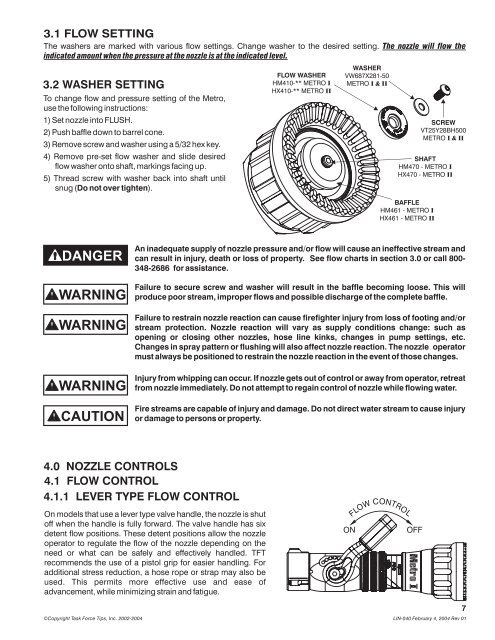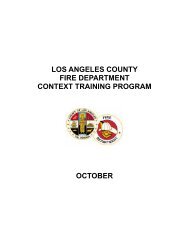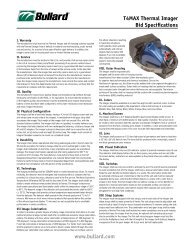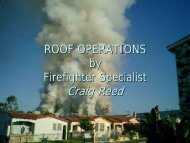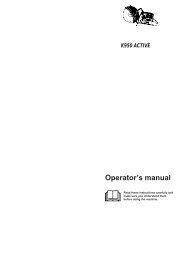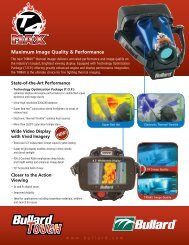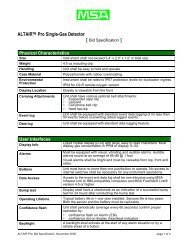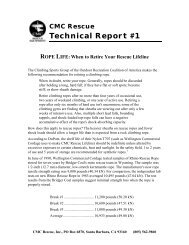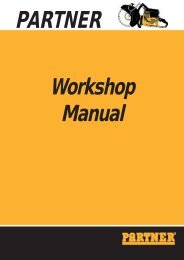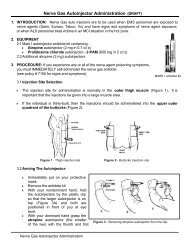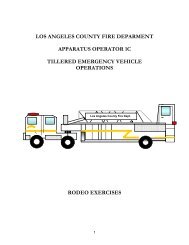MANUAL: Metro I & II Fixed Gallonage Nozzle - Los Angeles County ...
MANUAL: Metro I & II Fixed Gallonage Nozzle - Los Angeles County ...
MANUAL: Metro I & II Fixed Gallonage Nozzle - Los Angeles County ...
Create successful ePaper yourself
Turn your PDF publications into a flip-book with our unique Google optimized e-Paper software.
3.1 FLOW SETTING<br />
The washers are marked with various flow settings. Change washer to the desired setting. The nozzle will flow the<br />
indicated amount when the pressure at the nozzle is at the indicated level.<br />
3.2 WASHER SETTING<br />
To change flow and pressure setting of the <strong>Metro</strong>,<br />
use the following instructions:<br />
1) Set nozzle into FLUSH.<br />
2) Push baffle down to barrel cone.<br />
3) Remove screw and washer using a 5/32 hex key.<br />
4) Remove pre-set flow washer and slide desired<br />
flow washer onto shaft, markings facing up.<br />
5) Thread screw with washer back into shaft until<br />
snug (Do not over tighten).<br />
FLOW WASHER<br />
HM410-** METRO I<br />
HX410-** METRO <strong>II</strong><br />
WASHER<br />
VW687X281-50<br />
METRO I & <strong>II</strong><br />
SCREW<br />
VT25Y28BH500<br />
METRO I & <strong>II</strong><br />
SHAFT<br />
HM470 - METRO I<br />
HX470 - METRO <strong>II</strong><br />
BAFFLE<br />
HM461 - METRO I<br />
HX461 - METRO <strong>II</strong><br />
DANGER<br />
WARNING<br />
WARNING<br />
WARNING<br />
CAUTION<br />
An inadequate supply of nozzle pressure and/or flow will cause an ineffective stream and<br />
can result in injury, death or loss of property. See flow charts in section 3.0 or call 800-<br />
348-2686 for assistance.<br />
Failure to secure screw and washer will result in the baffle becoming loose. This will<br />
produce poor stream, improper flows and possible discharge of the complete baffle.<br />
Failure to restrain nozzle reaction can cause firefighter injury from loss of footing and/or<br />
stream protection. <strong>Nozzle</strong> reaction will vary as supply conditions change: such as<br />
opening or closing other nozzles, hose line kinks, changes in pump settings, etc.<br />
Changes in spray pattern or flushing will also affect nozzle reaction. The nozzle operator<br />
must always be positioned to restrain the nozzle reaction in the event of those changes.<br />
Injury from whipping can occur. If nozzle gets out of control or away from operator, retreat<br />
from nozzle immediately. Do not attempt to regain control of nozzle while flowing water.<br />
Fire streams are capable of injury and damage. Do not direct water stream to cause injury<br />
or damage to persons or property.<br />
4.0 NOZZLE CONTROLS<br />
4.1 FLOW CONTROL<br />
4.1.1 LEVER TYPE FLOW CONTROL<br />
On models that use a lever type valve handle, the nozzle is shut<br />
off when the handle is fully forward. The valve handle has six<br />
detent flow positions. These detent positions allow the nozzle<br />
operator to regulate the flow of the nozzle depending on the<br />
need or what can be safely and effectively handled. TFT<br />
recommends the use of a pistol grip for easier handling. For<br />
additional stress reduction, a hose rope or strap may also be<br />
used. This permits more effective use and ease of<br />
advancement, while minimizing strain and fatigue.<br />
©Copyright Task Force Tips, Inc. 2002-2004<br />
FLOW CONTROL<br />
ON<br />
OFF<br />
7<br />
LIN-040 February 4, 2004 Rev 01


